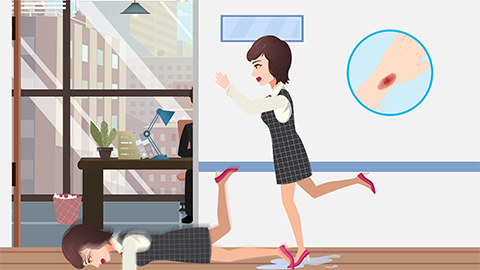How to treat a skin abrasion from a fall
Generally, skin abrasions can be managed through methods such as cleaning the wound, removing foreign objects, controlling bleeding, dressing the wound, and ongoing observation and care. If discomfort occurs, prompt medical attention is advised. Detailed explanations are as follows:

1. Clean the wound
After a skin abrasion, the wound surface may be contaminated with dust, bacteria, and other pollutants. If not cleaned properly, this can lead to infection, causing symptoms such as redness, swelling, and pus formation. Gently rinse the wound with normal saline or clean water to remove visible dirt. Then disinfect the surrounding skin with an antiseptic such as povidone-iodine, moving from the inside outward, to reduce the risk of infection.
2. Remove foreign objects
Foreign objects such as small stones or sand particles may become embedded in the wound. These can irritate the wound, hinder healing, and potentially cause inflammation. Carefully remove such objects using sterilized tweezers. If the foreign object is deeply embedded and difficult to extract, do not attempt forceful removal. Seek medical attention promptly to avoid causing further damage.
3. Control the bleeding
Skin abrasions often involve bleeding. Minor bleeding can usually be stopped by applying direct pressure. Pressure helps compress the broken blood vessels, allowing platelets to aggregate and form a clot, thereby stopping the bleeding. Apply clean gauze or a towel to the wound and press for several minutes. If the bleeding is heavy or does not stop easily, it may indicate injury to a larger blood vessel. In such cases, apply a pressure dressing and seek immediate medical care.
4. Dress the wound
Exposing the wound to the environment increases the risk of bacterial contamination and may cause pain or secondary injury due to friction from clothing. Therefore, depending on the size and location of the wound, choose an appropriate adhesive bandage or sterile gauze for dressing. The dressing should be neither too tight nor too loose—sufficient to protect the wound while maintaining proper blood circulation, thus creating a relatively clean environment for wound healing.
5. Observe and care for the wound
Infections or other complications may still occur after initial wound management, so close monitoring is necessary. If symptoms such as increased redness and swelling, worsening pain, discharge from the wound, or fever develop, infection may have occurred, and medical attention should be sought promptly. Additionally, keep the wound dry and avoid contact with water. Replace the adhesive bandage or gauze regularly to promote wound healing.
Appropriate measures should be taken based on the specific condition of the wound after a skin abrasion to ensure proper healing and prevent complications such as infection. If the situation is severe or beyond your ability to manage, seek professional medical assistance immediately.





